Meet Perezcope, the Controversial Internet Sleuth Who’s Roiling the Watch World
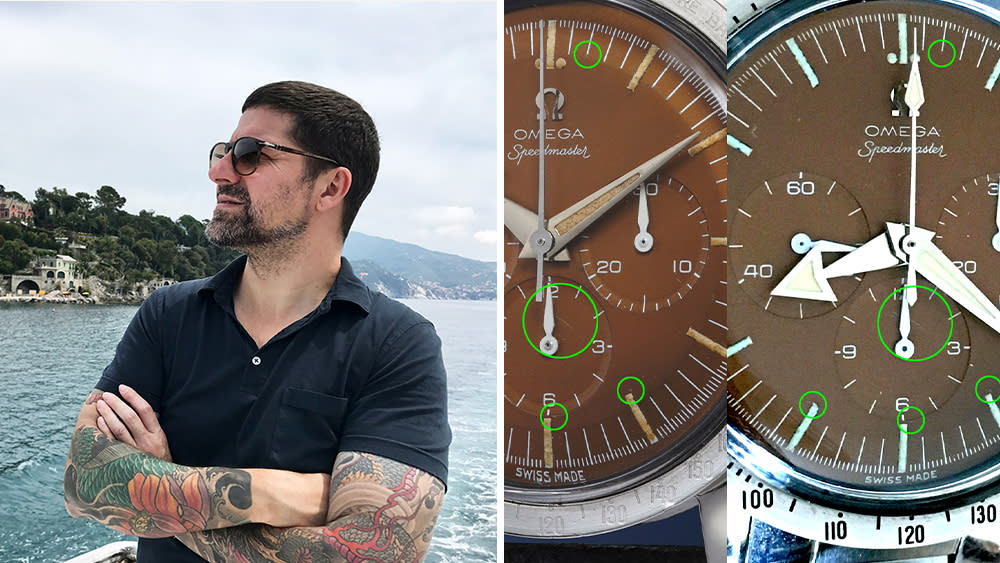
Wherever there are people making money legitimately, you’ll find others trying to make a buck by less scrupulous methods. And the watch world is no exception—particularly the vintage watch world, where the provenance of pieces many (many) decades old can often be almost impossible to establish with unflinching certainty.
Over the last couple of years, a number of ultra-high-value watches that have been, or were about to be, offered for sale have made headlines, due to claims that they’re either fake, or at least not all they seem to be (“Frankenwatches” made with a mix of real and inauthentic components or, in some cases, a mix of authentic parts from different eras). Each time, this has sent shockwaves through the rather insular and secretive world of fine watches and, on one occasion, may even end up as part of a trial in a Swiss court.
More from Robb Report
Greubel Forsey Just Added a Stylish New Watch to Its Coveted Convexe Collection
Material Good Opens Its Second Outpost in Miami Just in Time for Art Basel
At the center of these cases is a somewhat mysterious figure known largely by his Instagram handle, @Perezcope. The watch that definitively made the horological world pay attention to this internet sleuth was the Omega Speedmaster Ref. 2915-1, auctioned at Phillips in 2021, which he called out as being inauthentic, ultimately resulting in the Swiss watch brand filing a criminal complaint after an internal investigation revealed what it believes to have been shady business orchestrated by its very own employees (more on this later). So, who is he, and how did he become such a divisive yet influential figure in the world of watches?
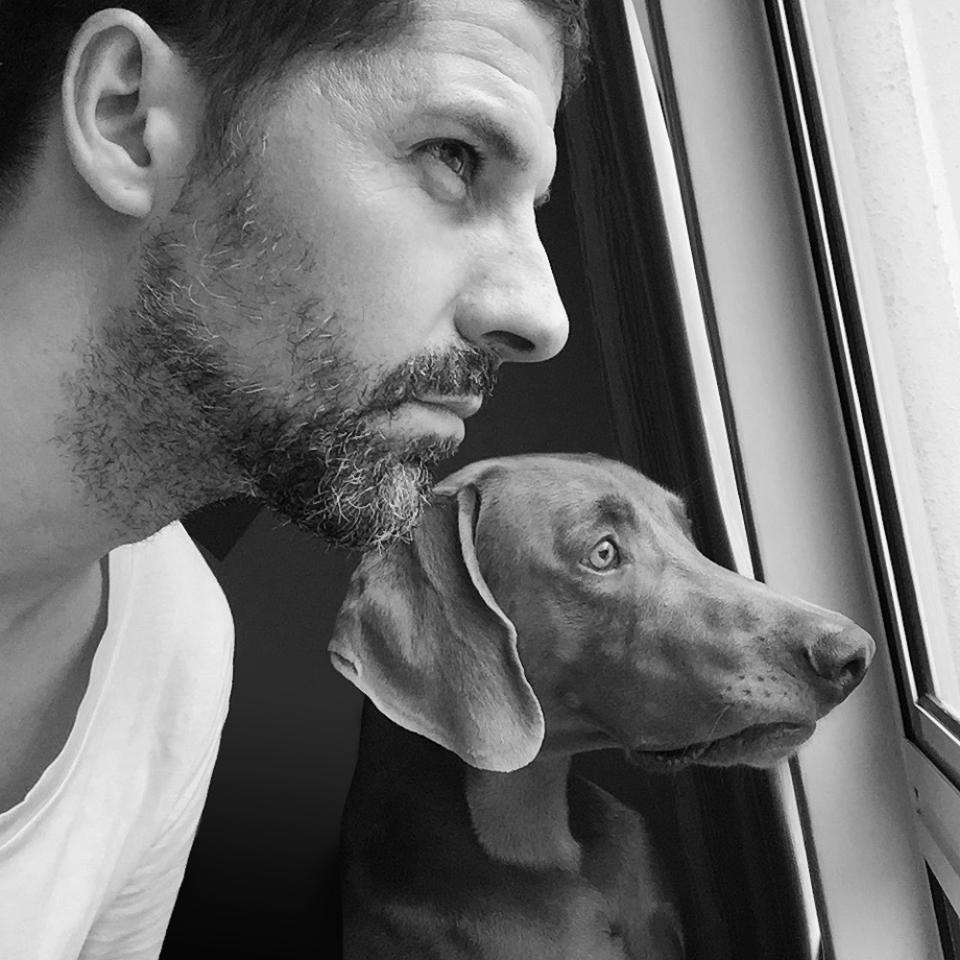
Perezcope operates under the alias Jose Pereztroika, which history students will recognize as a nod to the 1980s political-reform movement in the Soviet Union of the same name. His real name is Jose Perez, and he’s based in southeast Asia. He got into watches as a child, playing with his father’s collection, and bought his first luxury timpiece, a Breitling Navitimer, in 1999. Next came a Rolex Submariner 16800, but after that he became hooked on Panerai, which plays a big part in his story. He has been writing about the murky world of watches, particularly vintage ones, on his site since 2016.
But it was a piece from December 2022 that brought him to wider attention. In it, Perez called out a 1970 London Cartier Crash offered at the Phillips New York Watch Auction: Seven for having what he called a “far from ‘clean and original’ dial,” as well as claiming “serious issues with the case.” London Cartier Crash examples have fetched over $1 million at recent auctions, including a 1967 example that sold on Loupe This for over $1.6 million in May of 2022. The Phillips example originally had an estimate of $400,000 to $800,000 and was expected to hammer in for well above that top estimate. After the wider media and collector community picked up on Perez’s claim, the piece sold for just over $453,600—still a hefty price, but far below expectations. Many insiders offered praise for Perez’s detective work on his Instagram, including well-known Cartier collector, Roni Madhvani. “The thing I admire and respect about Perezcope is his single-minded pursuit in highlighting some of the rather sad and often hidden truths in the watch-collecting world,” Madhvani told Robb Report. “As prices of wristwatches have risen in the last few decades and new entrants have increased, some in the industry (brands, dealers, auctioneers) also see the greedy opportunity to exploit the situation and hoodwink collectors.” He says that buying vintage watches has become a minefield for both novice and experienced collectors alike—the difference between how pieces are described and the reality can sometimes be significant. “It is within this context that individuals such as Perezcope are seen as heroes for taking on and speaking out against this deceit, the extent of which remains hidden and unknown,” he says. “Despite the efforts to gag, threaten, and block individuals, it’s important that we are all able to speak out and there is freedom of speech and expression even in our world of horology and there is transparency over issues that are questioned.”
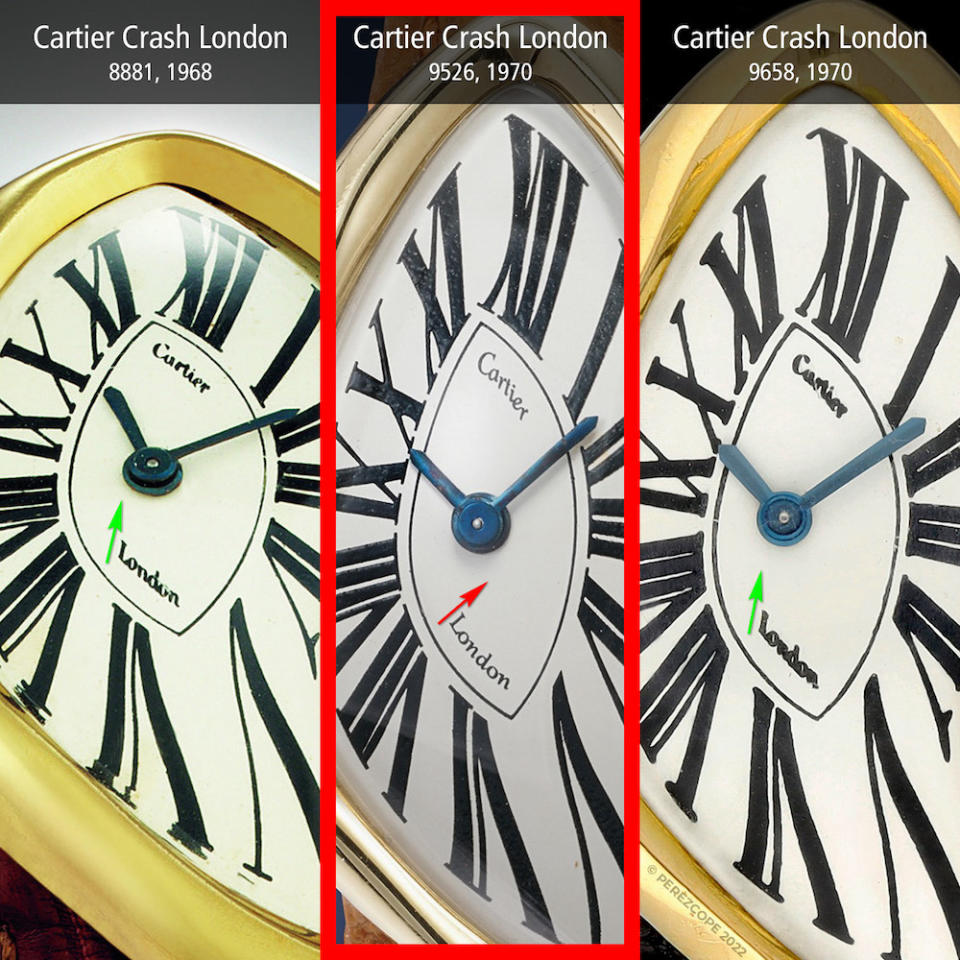
In this particular case, other afficionados pointed out that certain Cartier London watchmakers were rumored to produce unofficial versions “off-the-clock”, so to speak, thereby raising questions about whether this could have been one of those pieces. Most of the sources we spoke to for this story were not certain whether or not the piece was original.
Phillips, of course, stands by the Cartier London Crash. “Phillips does not offer watches unless we are 100 percent satisfied with their authenticity,” says a spokesperson for the auction house. “All watches are sold with a warranty which allows the buyer a refund in the unusual event a watch was shown not be authentic. Phillips welcomes scholarly debate, assessment, and criticism from the watch community on watches we offer for auction. As part of the vetting process, we take immediate action when credible criticism is raised, including discussions with noted scholars, experienced collectors, members of our advisory board, and whenever possible with the watchmaking brands who originally manufactured the watch. Phillips fully stands behind the Cartier Crash’s authenticity and disagrees with the allegations and false statements against it.”
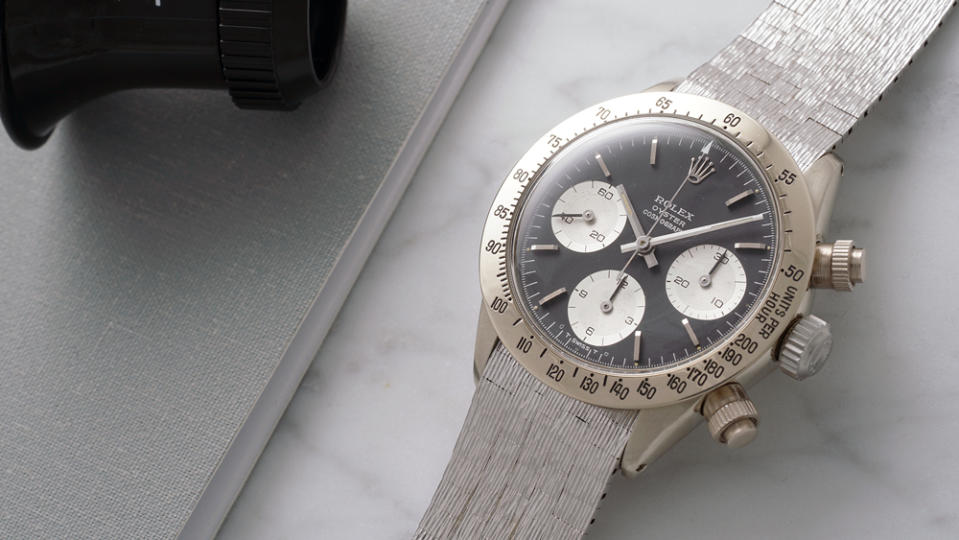
The Crash story was followed by more Perez bombs casting doubt over everything from a Rolex Daytona Ref. 16520 with a potentially fake “Beyer” dial signature to the famous Rolex Daytona Ref. 6265 “Unicorn” that sold at Phillips for $5.9 million in Geneva in May of 2018 (proceeds from the sale went to non-profit Geneva-based charity, Children Action). The latter came to auction via the well-known collector John Goldberger a.k.a Auro Montanari and is one of the most expensive watches ever sold. Unsurprisingly, Perez’s claims have earned him as many haters as admirers. “I do not like to talk about trolls or other similar people!” Montanari told Robb Report when we reached out to him for comment. “Please do not give importance to these kind of people. They do not have any impact on real and good collectors in the world. The virtual world of social media is not the real world. I am sorry.”
When we spoke with Perez from his home in Malaysia last month, he was quick to acknowledge his detractors, many of whom point out his involvement in an online forum, Homage Forum, during the late ‘90s and early 2000s, where people exchange information in creating “replicas.” His interest was in knock-off Panerais made using old pocket-watch movements and often treated to look vintage. “To age the case, they would take a new case and put it in a box with screws and stones and stuff and then shake it so it gets all of these marks like it has been used for many decades,” says Perez, who also says he created three watches using methods like these that he learned in the forum. He maintains, however, that it was just for fun and that he never sold any of them.
Nevertheless, it’s fuel to the fire for his critics. “They always bring up this story to try and discredit me, but what they don’t understand is that experience is not my kryptonite but actually my spinach,” he tells Robb Report, referring to the source of Popeye’s super-strength. “It made everything possible.” Who better to spot a fake, in other words, than someone who was been actively involved in creating them? “What’s really interesting about vintage [Panerai] is they were used in real missions. The historical component is what makes them special. So, I actually lost interest after the third watch.”
Instead, he posted about what he felt were fake Panerais on Paneristi.com, but, unsurprisingly, it didn’t go down well. People on the forum “ganged up on me, all of them, with personal attacks,” he says. “They were saying, ‘Oh, you’re a faker. You have ulterior motives. You shame people in public,’ or that I was some kind of puppet of some mysterious puppeteer somewhere who’s pulling the strings. And of course, none [of that] was true, but my thing was, like, I thought people would be interested in this knowledge.”
He says he was kicked off Paneristi.com in mid-September of 2015 (the forum did not respond to Robb Report’s inquiries for comment), and as a result, he launched Perezcope in mid-December that same year. “I started collecting more information and looking into the soul [of watches].” Soon, he began spotting what he saw as incorrect elements in other timepieces. “At some point, I moved on to other brands and models,” he says. “And, of course, with my experience that I had [creating fake Panerais], it was easy for me to see this fabrication in other watches.”
The former advertising executive, who is a Swiss national of Spanish origin, began digging deeper after partially retiring and leaving Europe for Asia. With plenty of free time on his hands he began creating extensive databases, not only from auction catalogs but also on popular models such as the Crash. He examined the details of the watch, comparing it to pictures and research he’d already collected.
“I reached out to Sotheby’s and asked them for detailed pictures of the [London Cartier Crash] watches that they had sold in previous years,” he says. “They sent them to me, and then I had a lot of dates to compare—especially the hallmarks, which are a big thing in that world. Hallmarks are stamped in an official capacity by the [British] government, and not by the brand.” He claims those on the Crash offered at Phillips were not stamped but cast, which raised a red flag. He also felt the dial was too cleanly printed compared to models in his database.
Robb Report has been unable to ascertain whether the piece has been verified as genuine. When asked whether or not the brand had been contacted to authenticate the piece either by Phillips or the end client, Cartier responded: “As we take client privacy very seriously, we would not be able to speak with anyone other than the client regarding purchases, products, etc.” Phillips did not respond specifically to our inquiry as to whether or not the piece had been authenticated with Cartier, but, as mentioned above, the auction house maintains that its vetting process does involve the brands that originally manufactured the pieces “whenever possible.”
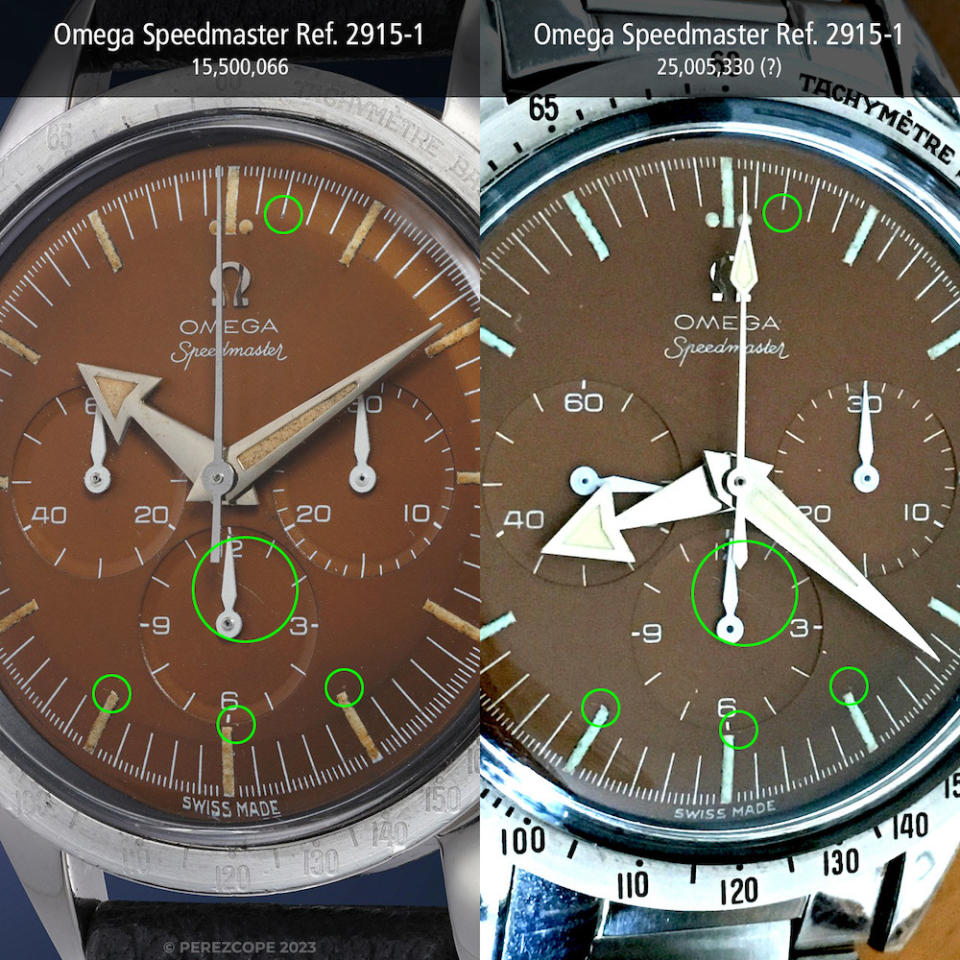
The one watch that unequivocally toppled under Perez’s scrutiny, however, was the Omega “Tropical” Speedmaster 2915-1, which became the most expensive Omega ever, fetching $3.4 million at Phillips Watch Auction: XIV in Geneva in November 2021. According to an April 2023 piece posted on Perezcope.com, the case, with its mirror-polished and rounded lugs, was suspect, the movement appeared to be from a later Speedmaster model and the hands looked as if they had been re-luminated, among other issues. Two months later, Bloomberg ran an article in which both Swatch Group (Omega’s parent company) and Phillips claimed they had been victims of counterfeit. It was later alleged that three former Omega employees from its heritage department and museum were involved in a scheme to create the watch, convincing the brand to buy it for their archives. A criminal complaint was filed by Omega with Swiss prosecutors in July. The case is still ongoing.
While Phillips’ auction pieces have garnered most of the recent attention, no major house has avoided Pereztroika’s gaze. Sotheby’s, Antiquorum, and Christie’s have all come under his spotlight for what he claims are potentially fake or doctored timepieces—all declined Robb Report’s request for comment. As a result of his work, Perez claims some of the auction houses have reached out to him not only to authenticate pieces before auction, but also write the essays for certain lots. He admits it makes for a strange relationship. “On the one hand, they need my help, because I might write an article,” he says. “On the other hand, I think they genuinely want to have a good relationship, you know?” Or they felt it was better to work with the enemy than be his target.
He is thanked by Sotheby’s in a catalog for its Important Watches sale in Geneva in 2019 “for his research on the topic” of a Panerai/Rolex Ref.3646 circa 1945. Specifically, he says Phillips reached out to him in 2018 to help the house authenticate watches. “I started working with them and then over the years, I started noticing that, even when I told them that some watches were not okay, they would just ignore it and put it at auction anyway,” claims Perez. He adds that when he would ask why they put the watch up for auction anyway he was told that they consulted another expert who overrode Perez’s assessment and verified the piece’s authenticity.
In response, a spokesperson from Phillips says, “As part of the vetting process, we take immediate action when credible criticism is raised.” The auction house did, however, confirm that Perez’s services had been employed in the past, and, in fact, the house has thanked him, along with John Goldberger and Jatucka, in an auction catalog for their “valuable assistance during the research of this piece” in regards to a Rolex Sea-Dweller “Single Red” Ref. 1665 sold at Phillips Hong Kong Watch Auction: Six in 2018. “Phillips paid a fee to access an aggregated database containing images and serial numbers of historic Rolex Daytona examples that had previously come to market,” says a Phillips spokesperson. “This was one of many tools we use for background research. The service consisted of sending serial numbers and images of candidate watches that would be compared against examples in the database. This service has never been used to physically inspect watches to help authenticate them.”
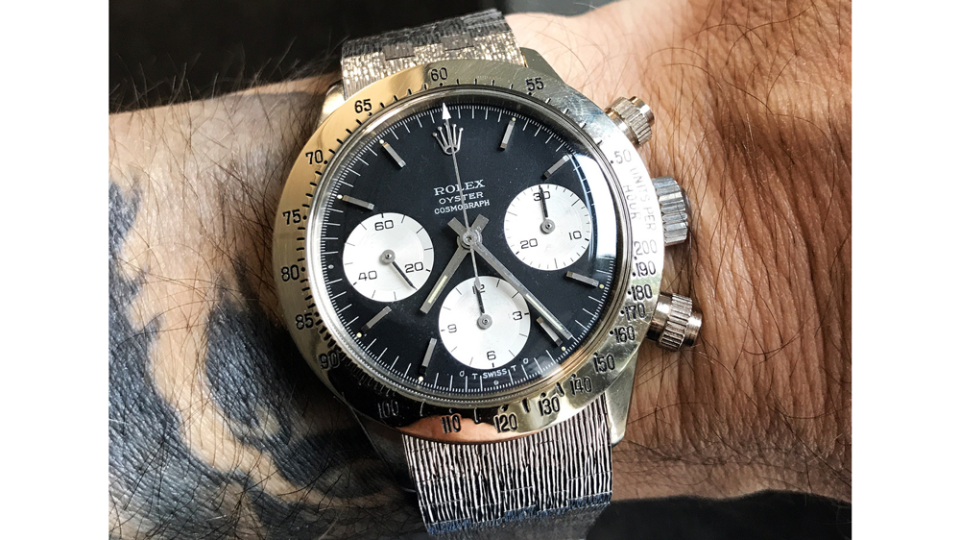
When asked whether or not he ever handles any of the watches in person, Perez says he does see some watches at auction previews and promptly sent over photos of his distinctively tattooed wrist wearing the Rolex Ref. 6265 “Unicorn” Daytona, Marlon Brando’s Rolex Ref. 1675 GMT-Master, and the Rolex Daytona Ref. 6263 “Arabian Knight” Daytona—all sold at Phillips for well over a million and, in the case of the “Unicorn,” multi-millions. “Whenever possible, I’ll go to the auction previews and check the watches in the metal,” says Perez.
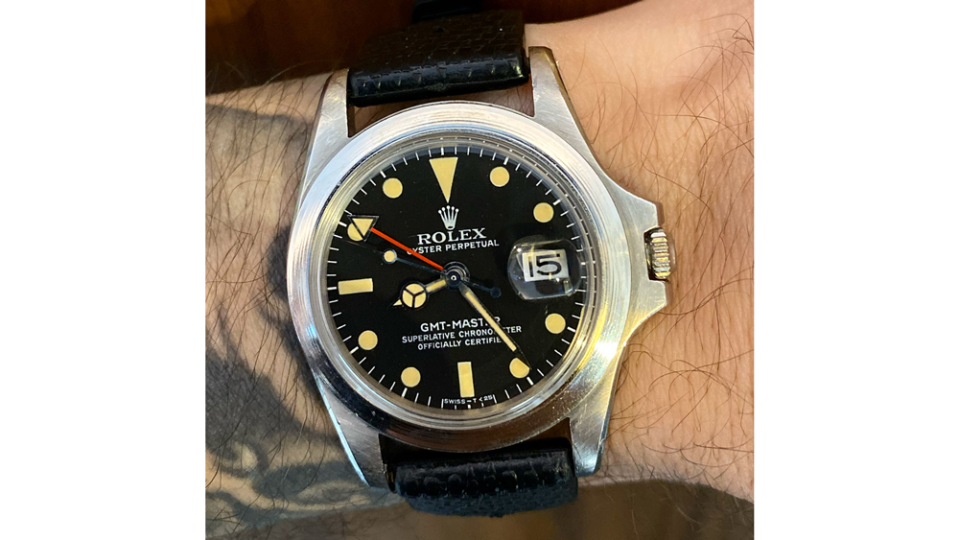
Despite his penchant for exposing potential fakes, Perez doesn’t believe most companies have nefarious intentions. “The problem with auction houses is that the knowledge is not there,” he says. “Sometimes they accept watches and just take them at face value, whatever the consigner tells them, and they don’t have this in-depth knowledge to understand whether the watch is correct or not. And of course, I mean, they’re salespeople, right? They just want to make money.”
Dealers who cut their teeth at auction houses before venturing out on their own agree. “I think it’s definitely true that auction houses don’t always have the best expertise in house,” says Eric Wind of Wind Vintage, a Palm Beach, Florida-based vintage dealer, who spent two and a half years as a senior specialist of watches at Christie’s before becoming an independent dealer. Part of the problem, he says, is that the houses don’t financially reward this level of expertise and many of the watch experts within these institutions, like himself, soon realize they can make more money dealing on their own, and have more control over the quality of pieces they’re bringing to clients.
Eric Ku, a well-known Berkeley, California-based dealer specializing in vintage Rolex, hasn’t worked at an auction house but has been tapped to work behind the scenes evaluating lots. He thinks auction houses do an admirable job of hiring experts, but agrees “private sector i.e. private dealing” can be more lucrative financially for those with advanced knowledge. Taking business into his own hands, Ku and business partner Justin Gruenberg, founded Loupe This, an auction platform aimed at bringing together, as Ku puts it, a company of experts.
Both Wind and Ku think Perez’s work demonstrates that buyers must be vigilant about doing their research. Wind says he doesn’t always agree with everything Perez writes, but claims he’s done more good than harm in terms of exposing bad behavior and fraud in the watch industry. “I think it’s important that people realize that everything they see isn’t 100 percent original,” says Wind. “It’s often a beautiful fiction, some of these watches that we see come up for auction.” Ku offers a similar sentiment. “Jose does an admirable job of policing the marketplace, and while some of the headlines he uses are a bit ‘loud,’ the research that goes into his conclusions are typically well thought out,” he says. “Jose’s research shows that certainly no one is infallible, and any serious collector should conduct their own research on what they plan on purchasing, instead of just relying on the words of the auction house.”
Of course, people such as Perez keep other experts in business. Wind believes auction houses shouldn’t be afraid to rely on outside expertise to further authenticate pieces. “People ask my opinion all the time and I give it for free often,” he says. He earns consulting fees for helping connoisseurs overhaul their collections, as well as get advice on which watches to purchase at auction.
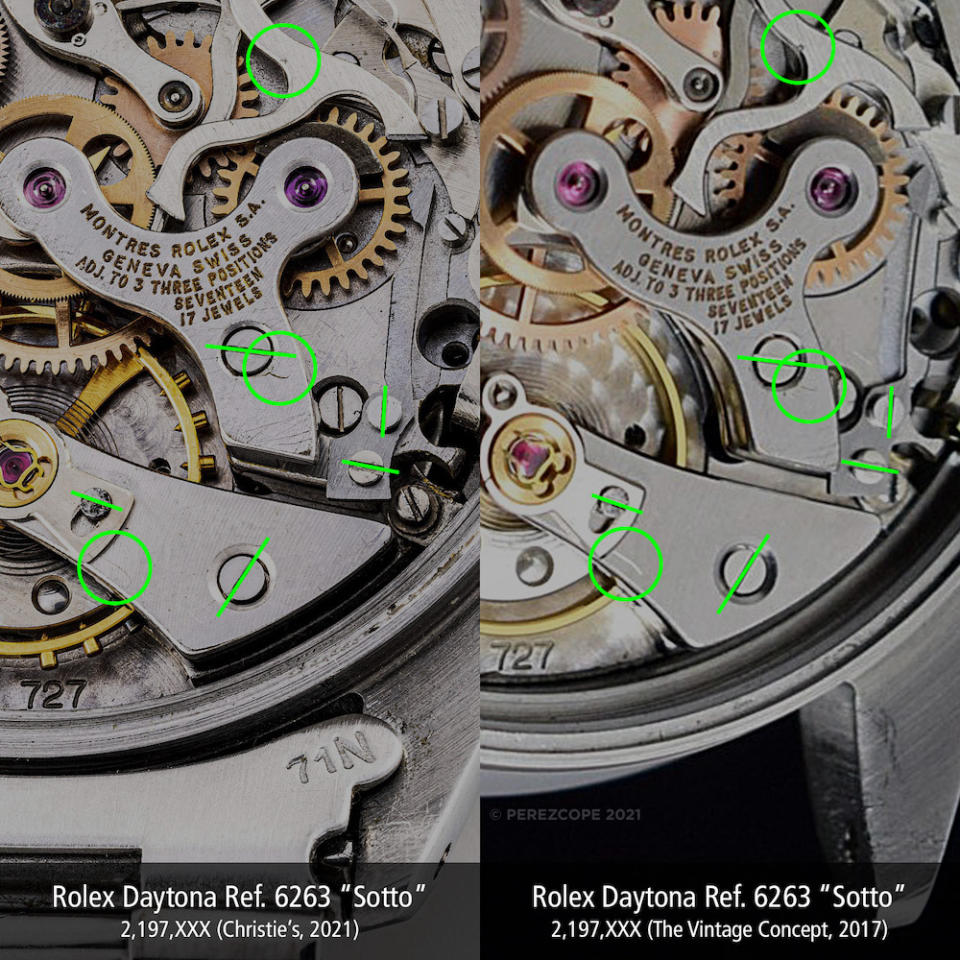
Perez is also capitalizing on the uncertainty in the secondary market. He says collectors pay him for his expertise, while others work with him quid pro quo by sharing knowledge that’s useful for his database. “Through the Omega thing, more and more people are reaching out to me, trying to figure out whether their watch is all right, because, of course, the more they hear about all this fakery that’s going on, the more concerned they are.”
Others, however, are less than enthused about the Sherlock Holmes of vintage watches. Some of his articles have generated serious push back, including, in one case, consistent threats from someone he suspects he’s written about. He claims the threats continued for three or four years, “spreading false accusations that I sold fake vintage Panerai watches to unsuspecting collectors in retaliation.” He adds that all of the allegations are “categorically false.” Phillips served Perez with an injunction from the Canton of Geneva in May of this year which prohibited him from publishing an article about the Geneva watch auction, but also generally prohibiting him from claiming or implying that Phillips is engaged in fraudulent conduct or offering for sale dubiously sourced watches [or otherwise infringing its personality rights]. What’s clear is that many critics feel very strongly: A group of seasoned collectors at the WatchTime event in New York recently told Robb Report that they felt he was purely interested in stirring up controversy. Some dealers we spoke with felt similarly but did not want to be on the record for fear that they would then become the focus of Perez’s attention. Others chose not to reply at all.
Despite this, Perez says his mission is simple: “The most important thing when I publish is that I share my knowledge so I help people learn about all this, so that they can next time see it for themselves.”
“I don’t want to be the guy who just claims things,” he says. “I want people to be able to discern all of this themselves.”
Best of Robb Report
Sign up for Robb Report's Newsletter. For the latest news, follow us on Facebook, Twitter, and Instagram.

